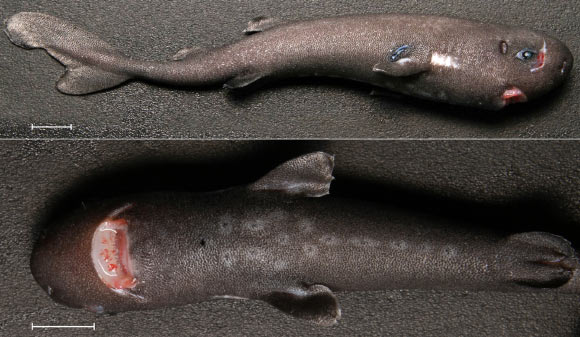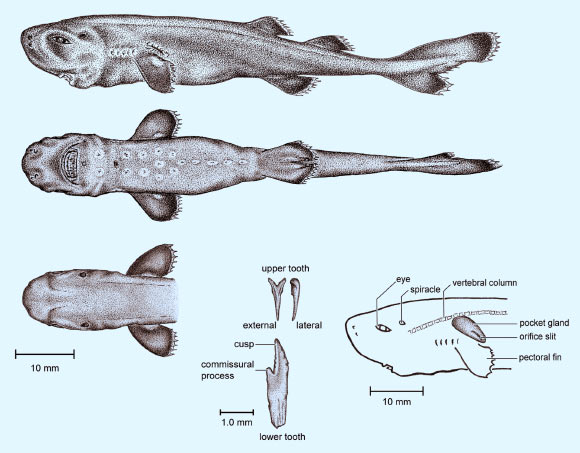Marine biologists have discovered what they say is the second specimen ever found of the pocket shark (Mollisquama parini).

A specimen of the pocket shark (Mollisquama parini) from the Gulf of Mexico, young male. Scale bars – 10 mm. Image credit: Mark A. Grace et al.
The pocket shark is one of the rarest species of the shark family Dalatiidae (sleeper sharks).
It was described in 1984 from a single specimen collected from the Nazca Submarine Ridge (off the coast of Chile) in the southeast Pacific Ocean. That specimen was a 40-cm-long female, taken at a depth of 1,083 feet (330 meters).
The new specimen of the pocket shark – only the second known record of this species – was collected in the deep sea about 190 miles (305 km) offshore Louisiana during a 2010 midwater trawl survey of the northern Gulf of Mexico conducted by NOAA/NMFS Southeast Fisheries Science Center, Mississippi Laboratories. The survey was conducted to explore possible fish and invertebrate prey associated with sperm whale aggregations.
“The pocket shark we found was only 5.5 inches (14.2 cm) long, weighed 14.6 g, and was a recently born male,” said Dr Mark Grace of NOAA/NMFS/SEFSC/Mississippi Laboratories, who is the first author of the paper published in the journal Zootaxa.
The specimen – when compared to the first specimen taxonomic description is found to have a series of glands along the abdomen not previously noted.
“The specimen was dead when initially sorted from the catch (catch sorting is generally completed within 30 min. after the net haul). A vertical dermal lesion of unknown origin, approximately 10.0 mm in length and located between the right eye orbit and snout, was present when the specimen was first examined prior to freezing,” Dr Grace and co-authors wrote in the Zootaxa paper.
“Body cylindrical anteriorly and somewhat laterally compressed for posterior two-thirds; tapers towards a slender caudal peduncle nearly circular in cross section at caudal fin origin.”
“Head large and wide and considerably deeper than rest of body; greatest width just posterior to spiracles. Sensory pores not immediately visible from superficial examination and if present covered by denticles. Bulbous snout short, blunt, and rounded in profile and widest just posterior of nostrils. Subterminal mouth originates beneath posterior half of orbit and jaws approximately equal length. When mouth is closed lower jaw teeth cover those of upper jaw.”
“When mouth is opened orifice irregularly rectangular (anterior margin of lower lip nearly horizontal); prominent lateral lips join upper and lower lips and conceal mouth corners. Nostrils small and directed forward with incurrent apertures spaced further apart than excurrent apertures. Eyes positioned level with nostrils and anterior to and just ventral of spiracles. Gill slits small; second is smallest and progressively larger to fifth slit.”
“Two low-profile spineless dorsal fins. First dorsal fin origin slightly anterior to body midpoint; insertion above pelvic fin origin. Interdorsal length less than caudal peduncle length. Length of second dorsal fin base greater than first. Pectoral fins small with broadly rounded apex and origin just anterior of last gill slit. Pelvic fins small and triangular and paired claspers not firm and do not extend past pelvic fin inner margins. Anal fin absent,” Dr Grace and his colleagues from the Tulane University Biodiversity Research Institute in Belle Chasse, LA, and Hollings Marine Laboratory in Charleston, SC, wrote in the paper.
“37 monospondylous vertebrae and 31 diplospondylous vertebrae (17 caudal peduncle, 14 caudal). Lower jaw tooth count estimate 15–1–15 and upper jaw tooth count 9–1–9.”
“Dorsal surface of head and body light gray with brownish undertones. Lateral line pigmented slightly darker than background body color from above gill slits to caudal peduncle. Ventral surface darker gray to black. Lighter pigmentation around and within mouth and area between gill slits cream colored distinct bar. Fins slightly darker than body. Pectoral fins nearly uniform dark grey except for pale blotch at posterior half of both dorsal and ventral sides of base. Pelvic fins darker towards posterior margins. Both dorsal fins darker than body ground color and distal portions of caudal fins black.”
Genetic analysis of the specimen indicated that pocket sharks are closely related to the kitefin and cookie cutter species, fellow members of Dalatiidae.
Like other sleeper sharks it is possible that pocket sharks when hungry may remove an oval plug of flesh from their prey – various marine mammals, large fishes and squid.
_____
Mark A. Grace et al. 2015. First record of Mollisquama sp. (Chondrichthyes: Squaliformes: Dalatiidae) from the Gulf of Mexico, with a morphological comparison to the holotype description of Mollisquama parini Dolganov. Zootaxa, vol. 3948, no. 3; doi: 10.11646/zootaxa.3948.3.10








